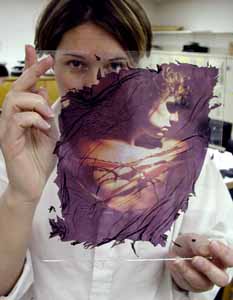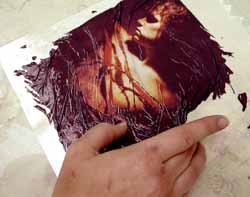Grant provides creative outlet for art
An undergraduate research grant gives photography majors an opportunity to express their creativity by studying emulsion transfers and lifts.
Marci McPherson, a senior photography major, said the emulsion transfer and lift research has brought an added outlet for creativity into the department for many students.
“As I’ve been doing this grant project, more people have been experimenting with the same thing,” she said. “And now it has become this whole creative environment.”
McPherson said the process for emulsion lifts starts by taking a 4×5 or 8×10 photograph and boiling it in water at 180 degrees for about 40 minutes.
The image becomes separated from the emulsion, the gelatin between the photograph and paper and the paper backing, which normally covers a photographic image, she said.
The image then lifts straight off the paper backing, she said.
Finally the image can be transferred onto any surface such as wood, glass or copper.
“The possibilities are open to your creativity,” she said.
There are many different methods for emulsion transfers and lifts, she said, but the system of boiling the entire picture in water for 40 minutes leaves the image more intact.
John Neely, art department head, said, “I saw the result of some of [McPherson’s] work and it looks very promising,” Neely said.
McPherson would not have been able to do this project without the funds from the Undergraduate Research and Creative Opportunity Grant (URCO), Neely said.
Neely said five grants were given to students in the art department this year.
Each project receives a different amount, but the emulsion transfer project is “the biggest one of the bunch,” Neely said.
McPherson said she started the project about a month ago and will finish in two weeks.
She said she discovered emulsion transfers one day when she saw a girl in the photo lab creating them and became fascinated with the process.
“My professor gave me the project and figured I’d be interested in it,” she said. “Art is seen as more of a fluff or frosting in academics, but I believe it is very important.”

Marcie McPherson, a senior majoring in photography, holds a polaroid lift that was recently completed. (Scott Davis )

